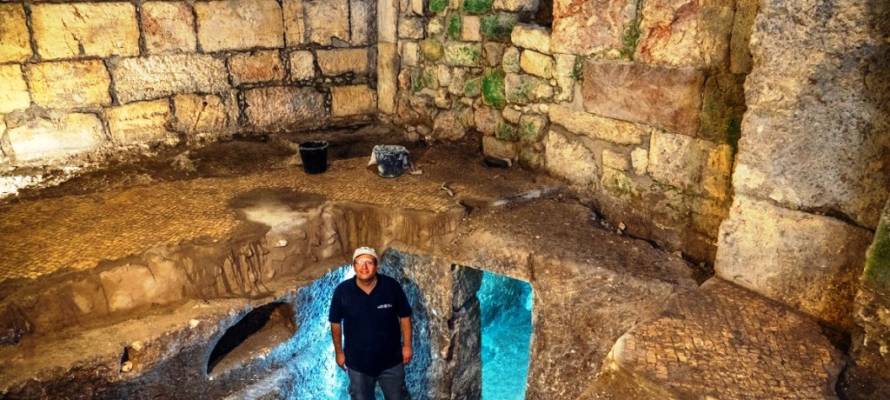
United with Israel

A unique subterranean system hewn in the bedrock from the Second Temple period was recently discovered beneath an impressive 1,400-year-old public building near the Western Wall, the first time such a system has been uncovered in the area.
By TPS
In honor of Jerusalem Day, celebrating Israel’s reunification of its capital during the 1967 Six-Day war, the Israel Antiquities Authority (IAA) and the Western Wall Heritage Foundation have revealed new and impressive archaeological discoveries uncovered under the lobby of the Western Wall Tunnels.
Researchers believe that the complex was used by Jerusalem residents during the Early Roman period, prior to the destruction of Jerusalem and the Second Temple in 70 C.E. The system was sealed beneath the floor of a large structure from the Byzantine period.
Archaeologists do not yet understand why such efforts and resources were invested in hewing the subterranean system 2,000 years ago, while life was going on in the homes above-ground.
This system was exposed in excavations conducted by the IAA in the Beit Straus complex, beneath the entrance lobby to the Western Wall Tunnels
The system is composed of an open courtyard and two rooms arranged in three levels, one above the other and connected by hewn staircases.
At the entrance to the rock-cut complex, depressions were found that were meant to firmly fix door hinges and bolts. Round and square niches were carved into the walls along with small triangular niches for oil-lamps, as well as elongated carving for shelves. These findings allude to the rock-cut system being for daily use.
First Discovery of Its Kind
Dr. Barak Monnickendam-Givon and Tehila Sadiel, directors of the excavation on behalf of the IAA, noted that “this is the first time a subterranean system has been uncovered adjacent to the Western Wall. The question is, why were such efforts and resources invested in hewing rooms underground in the hard bedrock? Perhaps it served as a pantry for an overhead structure that didn’t survive, or as a hewn space that allowed for subterranean living.”
“The findings discovered in this excavation shed light on the daily life of the residents of the ancient city,” they explained.
The archaeologists found clay cooking vessels, cores of oil lamps used for light, a stone mug unique to Second Temple-era Jewish sites, and a fragment of a Qalal – a large stone basin used to hold water, thought to be linked to Jewish practices of ritual purity.
The rock-cut system was completely covered by a plain white mosaic floor of a monumental and extremely impressive public structure built at the end of the Byzantine period about 1,400 years ago, renovated during the Abbasid period about 1,250 years ago.
The frequent renovations of the structure and its destruction reminded one of the IAA team members, Michael Chernin, of a letter from the Cairo Geniza dated back to the 11th century C.E. regarding the renovation of a synagogue in Jerusalem after the earthquake of 1035 C.E. The renovation was undertaken thanks to a donation made by the Jewish community of Tyre, Lebanon, to the Jewish community of Jerusalem.
Toward the Fatimid period in about 11th century C.E., the structure was destroyed and its contents were covered until being exposed during the current excavations.
The Beit Straus complex is named for the philanthropist Nathan Straus who purchased the structure near the Western Wall at the beginning of the 20th century and turned it into a soup kitchen that fed the poor of the city.
The excavations at the site, renewed about a year ago, are being conducted as part of the work to prepare for a new tour.
Monnickendam-Givon said that the excavations at Beit Straus “reveal Jerusalem in its glory: Jerusalem of people, religions, and a variety of groups who lived, worked, built, and glorified Jerusalem throughout the generations.”
The discovery was made by students of a pre-military preparatory program in Jerusalem. The students have been integrated into archaeological digs as part of the IAA’s educational policy, which connects youth with their history.
最近,在西墙附近一座有1400年历史的公共建筑下发现了一个从第二寺庙时期开始在基岩中挖掘的独特地下系统,这是该地区首次发现此类系统。
通过TPS
为了纪念耶路撒冷日,庆祝以色列在1967年六日战争期间重新统一首都,以色列文物局(IAA)和西墙遗产基金会披露了在西墙隧道大厅下发现的令人印象深刻的考古新发现。
研究人员认为,在公元前70年耶路撒冷和第二座神庙被毁之前,耶路撒冷居民在罗马早期使用了这个建筑群。该建筑群被封在拜占庭时期的一个大型建筑的地板下。
考古学家们还不明白为什么在2000年前,这些努力和资源被投入到挖掘地下系统,而生活却在地面上的房屋中进行。
该系统是由IAA在Beit Straus综合体进行的挖掘中暴露出来的,该综合体位于西墙隧道入口大堂的下方
该系统由一个开放式庭院和两个房间组成,分三层布置,一层高于另一层,通过凿出的楼梯连接。
在岩石切割综合体的入口处,发现了一些凹陷,用来牢固地固定门铰链和螺栓。墙壁上雕刻着圆形和方形壁龛,还有小的三角形壁龛,供油灯使用,还有细长的雕刻架。这些发现暗示了岩石切割系统是日常使用。
首次发现
代表IAA的挖掘主管Barak Monnickendam Givon和Tehila Sadiel博士指出,“这是第一次在西墙附近发现地下系统。问题是,为什么这些努力和资源被投资于在坚硬的基岩地下开凿房间?也许它是一个无法生存的高层建筑的储藏室,或者是一个允许地下生活的挖出的空间。”
他们解释说:“在这次发掘中发现的发现,为古城居民的日常生活提供了线索。”。
考古学家发现了粘土炊具、用于照明的油灯芯、第二个寺庙时代犹太遗址特有的石制杯子,以及一块Qalal的碎片,Qalal是一个用来盛水的大石头盆,被认为与犹太人的仪式纯洁性有关。
岩石切割系统完全被一层白色马赛克地板覆盖,这层地板是1400年前拜占庭时代末期建造的一座宏伟的、令人印象深刻的公共建筑,大约1250年前阿巴斯时期进行了翻修。
频繁的结构翻修和破坏让我们想起了IAA的一位成员Michael Chernin,一封回溯到公元前11世纪的开罗圣母院的信,信中提到在公元前1035年的地震后耶路撒冷的一个犹太教堂的翻修。翻修是由于黎巴嫩提尔的犹太社区向耶路撒冷的犹太社区捐赠的。
大约在公元前11世纪的法蒂玛王朝时期,该建筑被摧毁,其内容物被覆盖,直到在目前的挖掘中暴露出来。
贝特·斯特劳斯建筑群是以慈善家内森·斯特劳斯的名字命名的,他在20世纪初买下了西墙附近的建筑,并把它变成了一个汤厨房,为城市的穷人提供食物。
该遗址的挖掘工作大约在一年前重新开始,目前正在进行中,为新的参观作准备。
Monnickendam Givon说,在Beit Straus的挖掘“揭示了耶路撒冷的荣耀:耶路撒冷的人民、宗教和各种群体,他们世代居住、工作、建造和荣耀耶路撒冷。”
这一发现是由耶路撒冷一个战前准备项目的学生们发现的。作为IAA教育政策的一部分,这些学生已经融入到考古挖掘中,该政策将青年与他们的历史联系起来。

